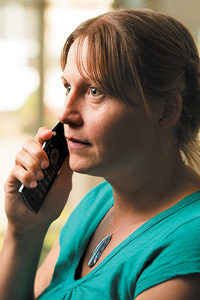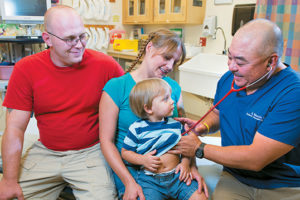Our Patients:
Kiernan Ward

On a laid-back Sunday morning, Doyle Ward had just ushered his four children outside for some yard work and gardening. In a moment of distraction, no one noticed 22-month-old Kiernan picking up a container from the recycling bin. Suddenly, 16-year-old Sabrina saw the upturned charcoal lighter fluid container and drips of liquid on Kiernan’s mouth and shirt. “He started coughing very deeply and appeared to be in distress,” Doyle says, as the leisurely Sunday turned chaotic.
Missouri Poison Center Director Julie Weber, RPh, CSPI, believes the Wards made the right call. “Our greatest service to the community is that we’re available 24 hours a day to calm that parent’s fears and answer the questions that help treat the patient,” she says. The Missouri Poison Center, a program of SSM Health Cardinal Glennon Children’s Hospital, provides a free, statewide, 24-hour service to the public and health care professionals.
Since 1974, the Poison Center has handled more than 2 million cases. In 2011, the Center handled 98,515 calls — 58,400 of which were human exposure cases.
As a hotline responder, Barb Eichhorn, RN, CSPI, receives frantic, tearful calls from parents. Stacy’s call concerned her because Kiernan already was displaying symptoms. “She sounded calm and in control, but I knew she was worried. You get pieces of the story as it unfolds. I didn’t know how much (he had ingested), but I knew he was already coughing,” Eichhorn explains.
Kiernan’s exposure warranted medical assessment, and Eichhorn advised the Wards to seek emergency treatment at SSM Health Cardinal Glennon. With their 9-1-1 call, an ambulance was already on its way. “EMS can monitor the patient, give oxygen if needed and relay information to the ED en route,” she says.
According to Weber, nearly 72 percent of the Poison Center’s exposure calls are handled without requiring a visit to the emergency department. Although always careful to err on the side of caution, the staff is trained to analyze the symptoms and the rapidity with which they evolve.
When the Wards arrived at SSM Health Cardinal Glennon, Kiernan’s coughing had decreased significantly, and Stacy felt confident he was recovering. “He was running down the hall, climbing on everything,” she says.
Doyle agreed, describing Kiernan’s behavior as ‘business as usual.’ “He was being himself — he’s a very lively child.”
Following hotline protocol, Eichhorn followed up to check Kiernan’s status. “Dr. Nakanishi already had it under control. He’s well-versed in hydrocarbons and aspirations,” she says.
Albert Nakanishi, MD, SSM Health Cardinal Glennon emergency medicine physician and associate professor of pediatrics at Saint Louis University School of Medicine, says that without a witness to the ingestion, it was important to conduct a history, exam and get a chest X-ray to detect aspiration of the hydrocarbon. “It’s easy to gag on the product. When you cough, you may inhale the hydrocarbon into the airway, which can cause pneumonitis,” he says. “It can be life-threatening depending on the nature of the ingestion — how much and how long before supportive care comes into play,” he continues. Although Kiernan’s chest X-ray was clear, Dr. Nakanishi recommended observing him for a few more hours. “The effects of toxic poison can be delayed,” he explains.
Doyle’s advice to parents: “Be attentive. Kids are extremely curious, and it doesn’t take long to get in serious trouble. If they do get in trouble, keep calm, and call the Poison Center.”

